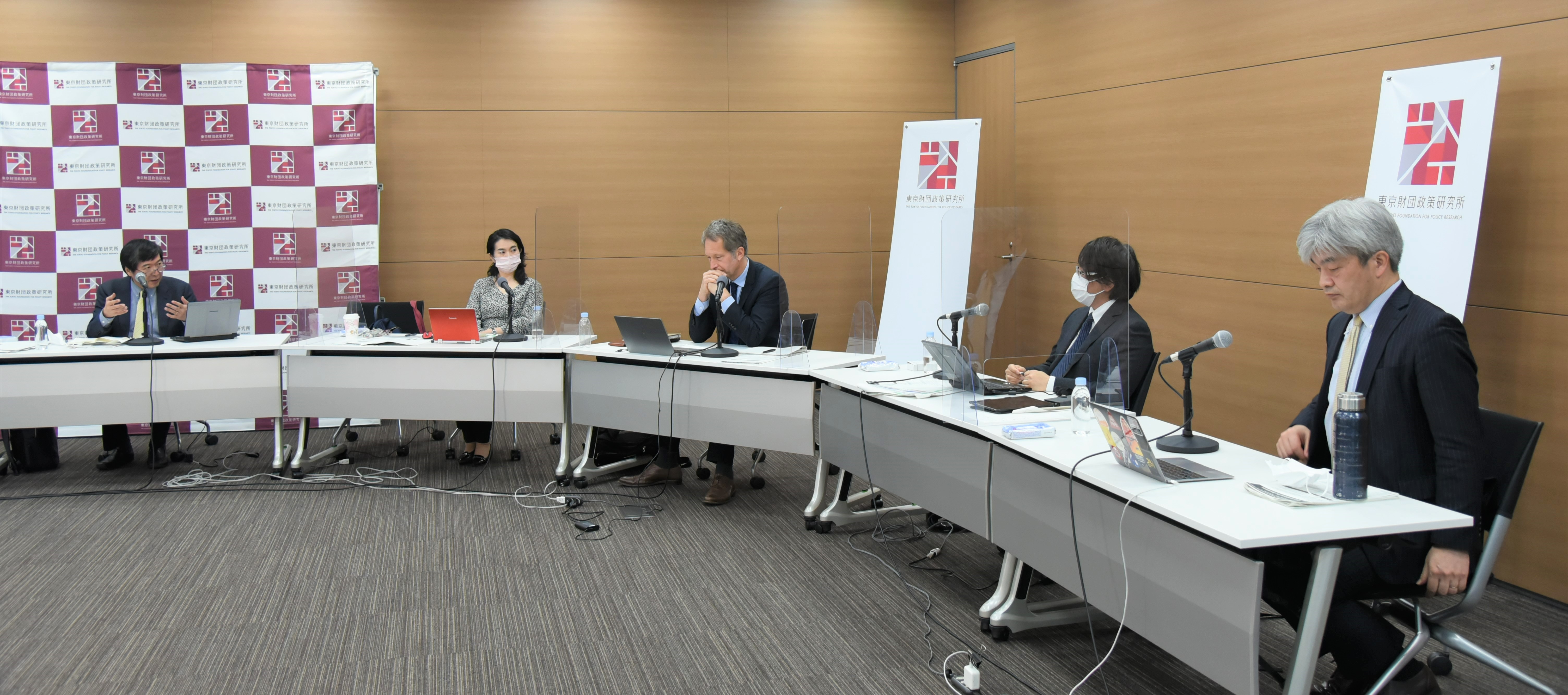
Redefining Sci-Tech Policy in Japan: A Multidimensional, Multiactor Approach
May 24, 2022
R-2021-071E
For years the Japanese government has sought to coordinate science and technology policy through the formation of top-down supra-ministerial policy councils. Meeting the needs of our complex and ever-changing sociotechnical landscape, though, requires a shift to a bottom-up, multiactor approach.
Linking Sci-Tech Policy to Social Transformation
Japan’s science and technology policy is undergoing a major shift as it broadens its focus from traditional scientific research to “strategic innovation” geared to social transformation across multiple fields. This conceptual shift has been evident since the adoption of the fourth Science and Technology Basic Plan in August 2011, but it is spelled out much more clearly in the latest Science, Technology, and Innovation Basic Plan, approved in March 2021. The change has been accelerated by a growing sense of urgency about the need to marshal our scientific know-how to meet such challenges as climate change, the COVID-19 pandemic, and digital transformation.
In the past, agency decisions on research funding involved very little external dialogue apart from the usual budget negotiations with the Ministry of Finance. Today’s sci-tech policy calls for coordination among a wide spectrum of policy actors inside and outside of government. It must take into account the larger international context, including such geopolitical factors as growing tensions between the United States and China. Moreover, in Japan, where the private sector accounts for a large share of total investment in research and development, policy makers must work closely with industry, whether by forging private-public partnerships or by organizing private R&D consortia. The government needs to set national priorities and impose appropriate guidelines and regulations, even while juggling these internal and external relationships.
All of this points to a redefinition of sci-tech policy in the dimensions of cross-domain, international, and cross-sectoral (public-private) relations. In the following, I will explore the nature of the changes required in each of these three realms and the competencies our policy actors will need to achieve such change.
Cross-Domain Dimension: The Limits of Top-Down Policy Making
There has been much discussion, among both scholars and practitioners of sci-tech policy, on the need for strategic management of technological development geared to social change. Transition management, a governance theory popular in Europe, stresses the importance of interaction among the “landscape,” “regime,” and “niche” levels of the sociotechnical system, as well as the need to monitor the coevolution of the regimes for different agencies, industries, and disciplines.[1] The Japanese government, cognizant of the need for strategic integration, has taken a number of steps in that direction, including the establishment of the Council for Science, Technology, and Innovation under the Cabinet Office and the launch of such cross-ministerial undertakings as the Strategic Innovation Program and the Moonshot Research and Development Program, also under the aegis of the Cabinet Office.
The Cabinet Office and the Cabinet Secretariat have played a rapidly growing role in sci-tech policy since the government reforms of 2001, designed to streamline policy making under the cabinet’s political leadership.[2] The establishment of the Council for Science and Technology Policy (now the Council for Science, Technology and Innovation Policy) under the Cabinet Office was one of the original features of that reform plan. Over the succeeding years, the Cabinet Secretariat became home to a plethora of discrete policy-making entities, including IT Strategic Headquarters, the Strategic Council on Intellectual Property, Global Warming Prevention Headquarters, Headquarters for Ocean Policy, and Headquarters for Healthcare Policy, while the Food Safety Commission and the Office for Nuclear Emergency Preparedness were placed under the aegis of the Cabinet Office. In 2014, a policy organ within the ruling Liberal Democratic Party submitted a set of recommendations for trimming this bloated apparatus, and in 2015 the government enacted a new law transferring some of the Cabinet Secretariat’s functions to the Cabinet Office and some of the latter’s back to other ministries.
As this history suggests, simply lumping more policy-making functions under the cabinet’s jurisdiction is not the answer to our sci-tech policy needs. What we need, rather, is to facilitate flexible, bottom-up collaboration by cultivating a sweeping, cross-sectional perspective and a capacity for collaboration among policy actors in various domains.
International Dimension: The Challenge of Global Trade
Sci-tech policy inevitably has a values-driven component, whether that means using technology to promote the values that society considers important or to prevent an erosion of those values. Countries differ in which societal values they seek to prioritize. As a consequence, efforts to facilitate the global spread of a given technology may entail international dialogue and negotiation to reconcile differing priorities and standards.
E-commerce is a prime example. While some countries seek to promote innovation oriented to the free flow of digital data across national borders, others place greater importance on privacy or security concerns.
The United States has tended to minimize restrictions on data flow with a view to promoting innovation. The EU, on the other hand, has built an extensive regulatory apparatus to ensure the protection of personal data, which it regards as a fundamental right. Under the EU’s General Data Protection Regulation, adopted in April 2016, the transfer of personal data to a third country or international organization may take place only if “an adequate level of protection” is ensured.[3] China’s Cybersecurity Law, enacted in 2017, prioritizes network security over the free flow of data. Article 37 states, “Critical information infrastructure operators that gather or produce personal information or important data during operations within the mainland territory of the People’s Republic of China, shall store it within mainland China. Where due to business requirements it is truly necessary to provide it outside the mainland, they shall follow the measures jointly formulated by the State cybersecurity and informatization departments and the relevant departments of the State Council to conduct a security assessment.”[4] As a result of such differences, the United States, the European Union, and China are now said to represent three distinct “data realms.”[5]
Thus far, the primary tool for reconciling such differences has been the negotiation of bilateral and regional trade frameworks, such as free trade agreements and economic partnership agreements. What this means is that management of bilateral and multilateral trade ties requires specialized knowledge of specific technologies as well as an integrated understanding of trade, economics, technological innovation, and diverse societal values.
Cross-Sectoral Dimension: Potential and Limits of Private Initiatives
Partnership between the public and private sectors is the third dimension of sci-tech policy reform. Today, technological development in emerging fields like AI and biotechnology is dispersed among a large number of businesses, and these private-sector actors are playing an expanding role in the formulation of regulations governing those technologies. This situation raises serious challenges from the standpoint of maintaining some level of public control over the development and deployment of innovative technology.
The history of nuclear power provides some instructive examples. A key challenge for nuclear power safety was ensuring the timely sharing of information, including safety issues and incidents, to enable continuous improvement among manufacturers and operators. In the United States, the Kemeny Commission on the 1979 Three-Mile Island accident called on the nuclear power industry to establish a program that would set safety standards, conduct independent evaluations and incident analyses, and ensure speedy dissemination of such information throughout the industry. The industry itself was highly motivated to police itself, since it had become clear that an accident at any one facility would undermine society’s confidence in other plants and manufacturers. Against this background, the , an independent, nonprofit entity, was established in 1979 as an industry initiative. Since then, INPO has served as an effective nongovernmental apparatus for internal education and regulation via the development and publication of rigorous safety standards, the conduct of plant evaluations, and the exchange of up-to-date information among members.
Japan has its corresponding entities: the Japan Nuclear Technology Institute, established in 2005, and the Japan Nuclear Safety Institute, created in 2012 in the wake of the Fukushima Daiichi nuclear disaster. However, these organizations appear to fall short of INPO, both in the rigor of their oversight and in the full and timely sharing of information among its members.[6]
The problem is that such private initiatives, while easing the burden on the public sector, do not obviate the need for independent regulators free from ties to private industry. How, then, does one nurture and secure the independent technical expertise required? In the United States, both INPO and the US Nuclear Regulatory Commission have relied heavily on the US Navy as an incubator for nuclear safety specialists. For Japan, which lacks a training ground for nuclear engineers outside of the electric power industry, building a truly independent regulatory apparatus has been a challenge.[7]
Building Capacity and Partnerships Among Policy Actors
As we have seen, today’s sci-tech policy demands collaboration among a growing number of actors spanning the cross-domain, international, and cross-sectoral dimensions. Moreover, these three dimensions frequently intersect. For example, cross-domain dialogue and collaboration is an important aspect of international negotiations, and it has also been identified as a key issue in cross-sectoral partnerships.
Instead of overburdening one or two executive agencies with the task of unifying all our sci-tech policies in a top-down manner, we need to facilitate bottom-up collaboration among a wide range of policy actors. This will require capacity building within government and nongovernment entities alike, together with the development of new institutional frameworks for cross-domain, international, and cross-sectoral collaboration.
[1] Derk Loorbach, Transition Management: New Mode of Governance for Sustainable Development, International Books, 2007.
[2] See Hideaki Shiroyama, Kagaku gijutsu to seiji (Politics and Technology), Minerva Publishing Co., 2017, Chapter 10.
[3] Yuko Suda, Deta puraibashi no kokusai seiji (International Politics of Data Privacy), Keiso Shobo Publishing, 2021, Chapter 1.
[4] https://digichina.stanford.edu/work/translation-cybersecurity-law-of-the-peoples-republic-of-china-effective-june-1-2017/
[5] Susan Ariel Aaronson and Patrick Leblond, “Another Digital Divide: The Rise of Data Realms and its Implications for the WTO,” Journal of International Economic Law, Vol. 21, 2018.
[6] See Hideaki Shiroyama, “Genshiryoku anzen kisei gyosei ni okeru noryoku kochiku no kokoromi to kadai” (Capacity Building Efforts and Challenges in Nuclear Safety Regulation), Nenpo Gyosei Kenkyu, No. 56, 2021.
[7] See Hideaki Shiroyama, Kagaku gijutsu to seiji (Politics and Technology), Minerva Publishing Co., 2017, Chapter 3.
















